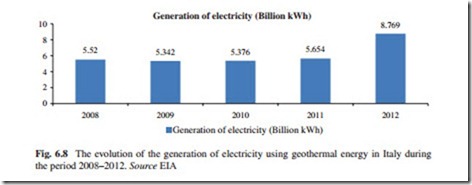Italy
According to EIA sources, Italy has in 2011 one of the largest installed geothermal capacity in the world (863 MW, the fifth largest capacity), has 51 % of the total geothermal electricity capacity in the EU (1,690 MW), and 7.6 % of the world total in 2011 (estimated at 11,430 MW located in at least 25 countries). Analysts estimate that Italy could have the largest per capita geothermal potential in the world.
Italy’s geothermal installations are concentrated around three sites: Larderello (563 MWe) (Fig. 6.7),5 Traveleadicondoli (160 MWe), and Monte Amiata (88 MWe) in southern Tuscany.6 Italy installed 10 new geothermal power plants over the last five years with a total capacity of 264 MW. In 2011, Italy has a total of 33 geothermal power plants operating in the country, which produced a total of 5,654 GWh. Italy’s ENEL Green Energy started operations in mid-2012 at its refurbished 17-MW Rancia two power plant in Tuscany. In addition, construction has commenced on the 40-MW Bagnore four power plant, also in Tuscany, at the projected cost of about €120 million, suggesting almost €3 million per MW of capacity.
Italy hosts the two main high-temperature geothermal deposits in Europe (810.5 MWe out of 1,059.9 MWe).
In 2012, the total electricity produced by the geothermal power plants operating in the country increased to 8,769 GWh; this represents an increase of 55.1 % with respect to 2011. The total contribution of the geothermal electricity to the total electricity generated by all renewable energy sources in Italy in 2011 was 7 %.
The Sustainable Energy Development of Italy until 2050 gives the highest penetration of renewable energy than in any of the scenarios envisaged until today, and it is expected to reach levels of at least 60 % of gross final consumption by 2050, with much higher levels in the electricity sector. According to this document, all of the country’s efforts must be focused on resuming sustainable growth. This can only happen through a substantial improvement in the competitiveness of the Italian economic system. Against this background, the Italian energy system
Geothermal Education Office
can and must play a key role in improving Italian competitiveness. To achieve this, the government needs to address some important challenges:
• Energy prices for businesses and families that are higher than in other European countries;
• Security of supply that is by no means optimal at peak loads, especially as
regards natural gas, and a high dependence on imported fossil fuels;
• Economic and financial difficulties experienced by a number of operators in the sector.
Generation of Electricity Using Geothermal Energy
According to the Sustainable Energy Development of Italy until 2050 report, the evolution of the production mix until 2020 envisages a significant increase in the part played by the use of renewable energy sources in all sectors (electricity, heat, and transport). Renewables are expected to amount in total up to 22–23 % of primary consumption, compared to 11 % in 2010, with the share represented by fos- sil fuels gradually decreasing while still remaining predominant (approximately 76 % of primary consumption). More specifically, the mix in the electricity sector will increasingly be based on gas and renewables, a trend expected to be followed
by other European countries too. The importance of renewables in the consumption mix is expected to reach the same level that the gas has now: 35–37 %, and both are expected to produce 75 % of the total electricity generated by the country.
The total electricity generated using geothermal power plants represents in 2012 only 2 % of the total electricity generated in the country, a reduction of 5 % with respect to 2011.
The evolution of the generation of electricity using geothermal energy in Italy during the period 2008–2012 is shown in Fig. 6.8.
According to Fig. 6.8, the generation of electricity in Italy using geothermal energy source increased 58.9 %. During the period 2008–2011, the generation of electricity using geothermal energy remained stable around 5.5–5.6 billion kWh. The highest increase was reported in 2012 (55 %). It is expected that the generation of electricity in Italy using this type of energy source will continue increasing during the coming years.

